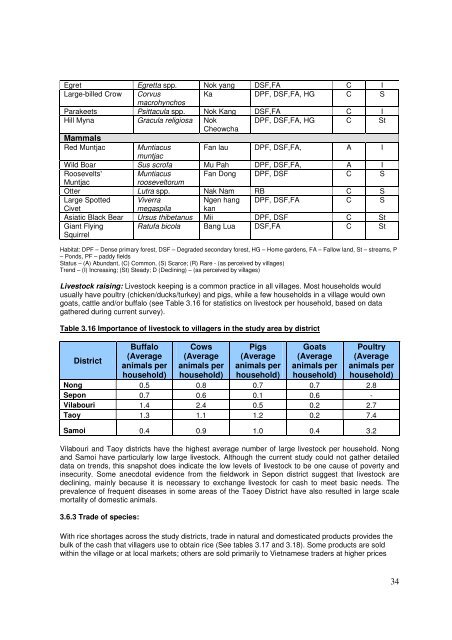Part 1 – A Rapid Participatory Biodiversity Assessment - IUCN
Part 1 – A Rapid Participatory Biodiversity Assessment - IUCN
Part 1 – A Rapid Participatory Biodiversity Assessment - IUCN
You also want an ePaper? Increase the reach of your titles
YUMPU automatically turns print PDFs into web optimized ePapers that Google loves.
Egret Egretta spp. Nok yang DSF,FA C I<br />
Large-billed Crow Corvus<br />
macrohynchos<br />
Ka DPF, DSF,FA, HG C S<br />
Parakeets Psittacula spp. Nok Kang DSF,FA C I<br />
Hill Myna<br />
Mammals<br />
Gracula religiosa Nok<br />
Cheowcha<br />
DPF, DSF,FA, HG C St<br />
Red Muntjac Muntiacus<br />
muntjac<br />
Fan lau DPF, DSF,FA, A I<br />
Wild Boar Sus scrofa Mu Pah DPF, DSF,FA, A I<br />
Roosevelts' Muntiacus Fan Dong DPF, DSF C S<br />
Muntjac<br />
rooseveltorum<br />
Otter Lutra spp. Nak Nam RB C S<br />
Large Spotted Viverra<br />
Ngen hang DPF, DSF,FA C S<br />
Civet<br />
megaspila kan<br />
Asiatic Black Bear Ursus thibetanus Mii DPF, DSF C St<br />
Giant Flying<br />
Squirrel<br />
Ratufa bicola Bang Lua DSF,FA C St<br />
Habitat: DPF <strong>–</strong> Dense primary forest, DSF <strong>–</strong> Degraded secondary forest, HG <strong>–</strong> Home gardens, FA <strong>–</strong> Fallow land, St <strong>–</strong> streams, P<br />
<strong>–</strong> Ponds, PF <strong>–</strong> paddy fields<br />
Status <strong>–</strong> (A) Abundant, (C) Common, (S) Scarce; (R) Rare - (as perceived by villages)<br />
Trend <strong>–</strong> (I) Increasing; (St) Steady; D (Declining) <strong>–</strong> (as perceived by villages)<br />
Livestock raising: Livestock keeping is a common practice in all villages. Most households would<br />
usually have poultry (chicken/ducks/turkey) and pigs, while a few households in a village would own<br />
goats, cattle and/or buffalo (see Table 3.16 for statistics on livestock per household, based on data<br />
gathered during current survey).<br />
Table 3.16 Importance of livestock to villagers in the study area by district<br />
District<br />
Buffalo<br />
(Average<br />
animals per<br />
household)<br />
Cows<br />
(Average<br />
animals per<br />
household)<br />
Pigs<br />
(Average<br />
animals per<br />
household)<br />
Goats<br />
(Average<br />
animals per<br />
household)<br />
Poultry<br />
(Average<br />
animals per<br />
household)<br />
Nong 0.5 0.8 0.7 0.7 2.8<br />
Sepon 0.7 0.6 0.1 0.6 -<br />
Vilabouri 1.4 2.4 0.5 0.2 2.7<br />
Taoy 1.3 1.1 1.2 0.2 7.4<br />
Samoi 0.4 0.9 1.0 0.4 3.2<br />
Vilabouri and Taoy districts have the highest average number of large livestock per household. Nong<br />
and Samoi have particularly low large livestock. Although the current study could not gather detailed<br />
data on trends, this snapshot does indicate the low levels of livestock to be one cause of poverty and<br />
insecurity. Some anecdotal evidence from the fieldwork in Sepon district suggest that livestock are<br />
declining, mainly because it is necessary to exchange livestock for cash to meet basic needs. The<br />
prevalence of frequent diseases in some areas of the Taoey District have also resulted in large scale<br />
mortality of domestic animals.<br />
3.6.3 Trade of species:<br />
With rice shortages across the study districts, trade in natural and domesticated products provides the<br />
bulk of the cash that villagers use to obtain rice (See tables 3.17 and 3.18). Some products are sold<br />
within the village or at local markets; others are sold primarily to Vietnamese traders at higher prices<br />
34

















